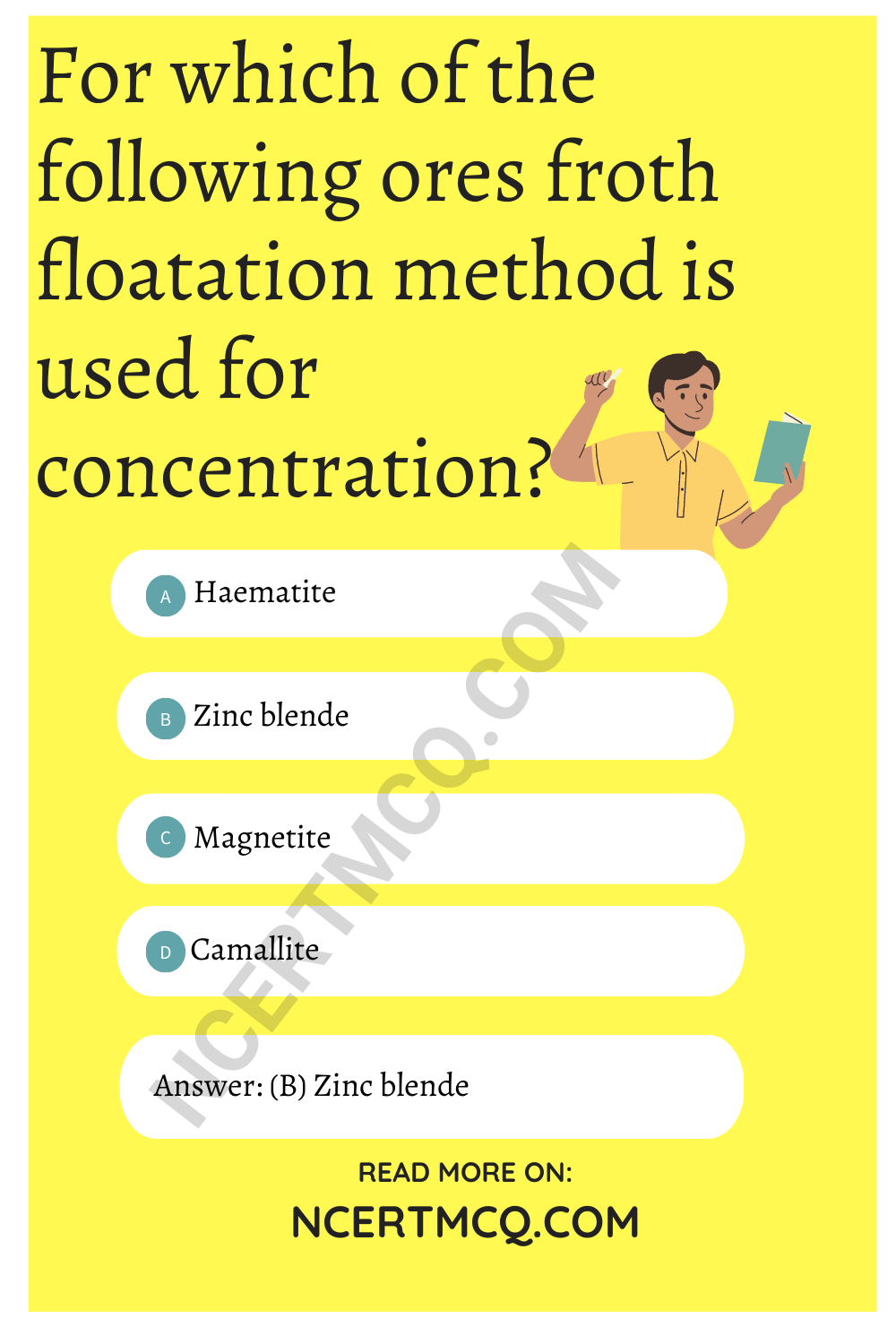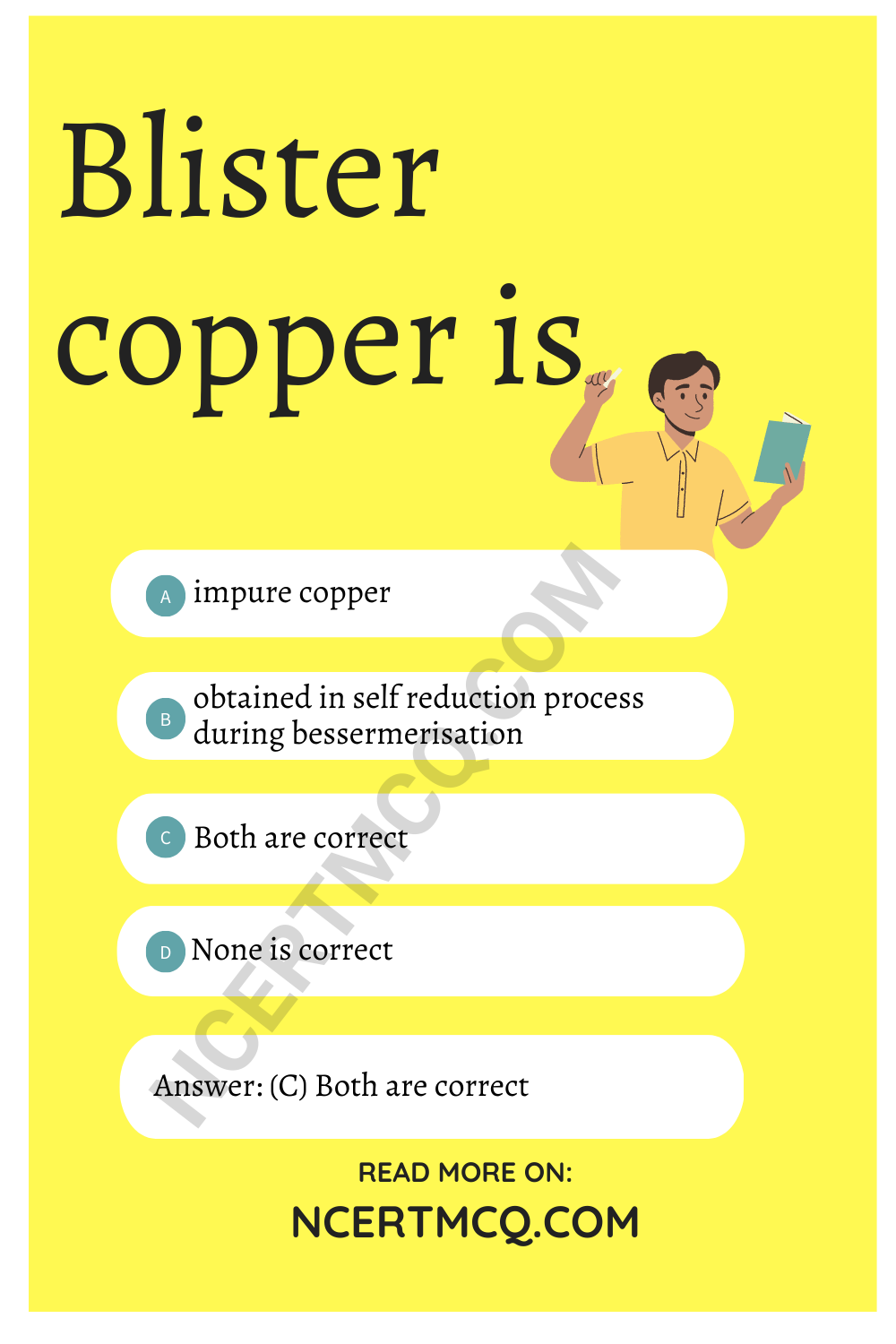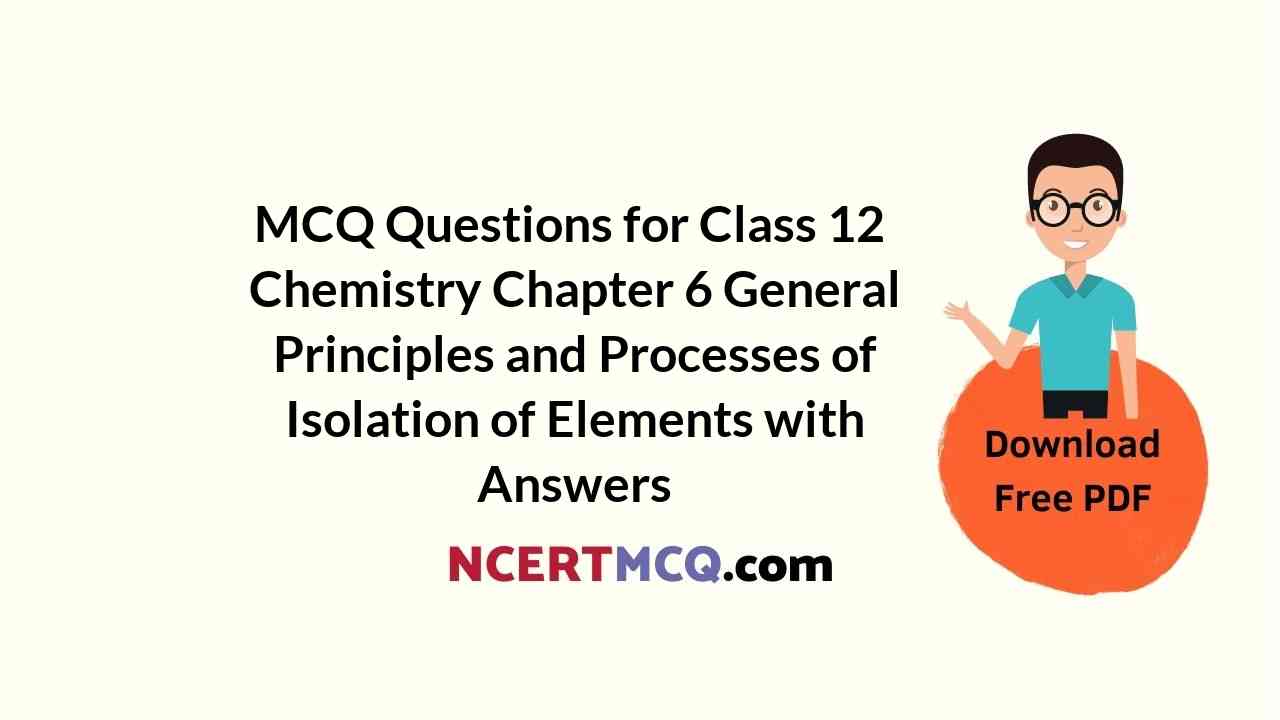Check the below NCERT MCQ Questions for Class 12 Chemistry Chapter 6 General Principles and Processes of Isolation of Elements with Answers Pdf free download. MCQ Questions for Class 12 Chemistry with Answers were prepared based on the latest exam pattern. We have provided General Principles and Processes of Isolation of Elements Class 12 Chemistry MCQs Questions with Answers to help students understand the concept very well.
Class 12 Chemistry Chapter 6 MCQ With Answers
Chemistry Class 12 Chapter 6 MCQs On General Principles and Processes of Isolation of Elements
Metallurgy MCQ Questions Class 12 Question 1.
Concentration of sulphide ore is done by
(a) froth flotation process
(b) electrolysis
(c) roasting
(d) None of these
Answer
Answer: (a) froth flotation process
MCQ On Metallurgy Class 12 Question 2.
Malachite is an ore of
(a) iron
(b) copper
(c) zinc
(d) Sliver
Answer
Answer: (b) copper
General Principles And Processes Of Isolation Of Elements MCQ Question 3.
Formula of copper pyrite is
(a)Cu2S
(b) CuFeS
(c) CuFeS2
(d) Cu2Fe2S2
Answer
Answer: (c) CuFeS2
MCQ On General Principles And Processes Of Isolation Of Elements Question 4.
Ore of aluminium is
(a) bauxite
(b) hematite
(c) dolomite
(d) None of these
Answer
Answer: (a) bauxite
MCQ On Metallurgy Class 12 Pdf Question 5.
Removal of the unwanted materials like sand, clays, etc. from the ore is known as ………., …….. or ……….
(a) concentration, dressing, benefaction
(b) separation, refining, gangue
(c) magnetic separation, purification, gangue
(d) washing, refining, amalgamation
Answer
Answer: (a) concentration, dressing, benefaction
Metallurgy Class 12 MCQ Question 6.
For which of the following ores froth floatation method is used for concentration?
(a) Haematite
(b) Zinc blende
(c) Magnetite
(d) Camallite
Answer
Answer: (b) Zinc blended

Class 12 Chemistry Chapter 6 MCQ Question 7.
The powdered ore is agitated with water or washed with running stream of water. The heavy ore particles and lighter impurities are separated. This method of concentration is known as
(a) metallurgy
(b) leaching
(c) froth floatation process
(d) gravity separation
Answer
Answer: (d) gravity separation
General Principles And Processes Of Isolation Of Elements MCQs Pdf Question 8.
The oil used as frothing agent in froth floatation process is
(a) coconut oil
(b) castor oil
(c) palmitic oil
(d) pine oil
Answer
Answer: (d) pine oil
General Principles And Processes Of Isolation Of Elements Class 12 MCQ Question 9.
Which of the following metals is not extracted by leaching?
(a) Aluminium
(b) Mercury
(c) Silver
(d) Gold
Answer
Answer: (b) Mercury
Metallurgy Quiz Class 12 Question 10.
Sulphide ore of zinc/copper is concentrated by
(a) floatation process
(b) electromagnetic process
(c) gravity separation
(d) distillation
Answer
Answer: (a) floatation process
Class 12 Chemistry Chapter 6 MCQs Question 11.
Which of the following ores is concentrated by chemical leaching method?
(a) Cinnabar
(b) Argentite
(c) Copper pyrites
(d) Galena
Answer
Answer: (b) Argentite
MCQ Questions For Class 12 Chemistry Chapter 6 Question 12.
How do we separate two sulphide ores by froth floatation method?
(a) By using excess of pine oil
(b) By adjusting proportion of oil to water or using depressant.
(c) By using some solvent in which one of the sulphides is soluble
(d) By using collectors and froth stabilisers like xanthates
Answer
Answer: (b) By adjusting proportion of oil to water or using depressant.
MCQ Of Metallurgy Class 12 Question 13.
Common impurities present in bauxite are
(a) CuO
(b) ZnO
(c) CaO
(d) SiO2
Answer
Answer: (d) SiO2
Question 14.
An ore of tin containing FeCrO4 is concentrated by
(a) gravity separation
(b) magnetic separation
(c) froth floatation
(d) leaching
Answer
Answer: (b) magnetic separation
Question 15.
Which of the following ores cannot be concentrated by magnetic separation?
(a) Haematite
(b) Malachite
(c) Magnetite
(d) Siderite
Answer
Answer: (b) Malachite
Question 16.
The significance of leaching in the extraction of aluminium is
(a) it helps removing the impurities like SiO2, Fe2O3 etc. from the bauxite ore
(b) it converts the ore into oxide
(c) it reduces melting point of the ore
(d) it eliminates water from bauxite
Answer
Answer: (a) it helps removing the impurities like SiO2, Fe2O3 etc. from the bauxite ore
Question 17.
Which of the following metals is extracted using a silica lined convertor?
(a) Mg
(b) Al
(c) Cu
(d) Zn
Answer
Answer: (c) Cu
Question 18.
Which of the following sulphides when heated strongly in air gives the corresponding metal without undergoing separate reduction of oxide?
(a) Cu2S
(b) FeS
(c) HgS
(d) ZnS
Answer
Answer: (c) HgS
Question 19.
Which of the following metals cannot be obtained by reduction of its metal oxide bv aluminium ?
(a) Cr
(b) Mn
(c) Fe
(d) Mg
Answer
Answer: (d) Mg
Question 20.
Heating pyrites to remove sulphur is called
(a) smelting
(b) calcination
(c) liquation
(d) roasting
Answer
Answer: (d) roasting
Question 21.
Impurities of sulphur, silicon and phosphorus can be removed from cast iron by adding
(a) carbon which reduces the impurities
(b) water which dissolves the impurities
(c) limestone which changes impurities into oxides and pass into slag
(d) iron oxide which reacts with impurities by forming slag
Answer
Answer: (c) limestone which changes impurities into oxides and pass into slag
Question 22.
In metallurgical process, aluminium acts as
(a) an oxidising agent
(b) a reducing agent
(c) acidic flux
(d) basic flux
Answer
Answer: (b) a reducing agent
Question 23.
Ellingham diagram represents change of
(a) ΔG with temperature
(b) ΔH with temperature
(c) ΔG with pressure
(d) (ΔG – TΔS) with temperature
Answer
Answer: (a) ΔG with temperature
Question 24.
During the extraction of haematite, limestone is added which acts as
(a) flux
(b) slag
(c) reducing agent
(d) gangue
Answer
Answer: (a) flux
Question 25.
In blast furnace iron oxide is reduced by
(a) silica
(b) carbon monoxide
(c) carbon
(d) lime stone
Answer
Answer: (b) carbon monoxide
Question 26.
From the Ellingham graph between Gibb’s energy and temperature, out of C and CO with is a better reducing agent for ZnO?
(a) Carbon
(b) CO
(c) Both of these
(d) None of these
Answer
Answer: (a) Carbon
Question 27.
In a thermite process is used as reducing agent.
(a) Zn
(b) Al
(c) Mn
(d) Fe
Answer
Answer: (b) Al
Question 28.
Blister copper is
(a) impure copper
(b) obtained in self reduction process during bessermerisation
(c) Both are correct
(d) None is correct
Answer
Answer: (c) Both are correct

Question 29.
Which of the following slags is produced during extraction of iron?
(a) CaSiO3
(b) FeSiO3
(c) MgSiO3
(d) ZnSiO3
Answer
Answer: (a) CaSiO3
Question 30.
Which of the following oxides cannot be reduced by hydrogen?
(a) Ferric oxide
(b) Aluminium oxide
(c) Zinc oxide
(d) Cupric oxide
Answer
Answer: (b) Aluminium oxide
We hope the given NCERT MCQ Questions for Class 12 Chemistry Chapter 6 General Principles and Processes of Isolation of Elements with Answers Pdf free download will help you. If you have any queries regarding General Principles and Processes of Isolation of Elements CBSE Class 12 Chemistry MCQs Multiple Choice Questions with Answers, drop a comment below and we will get back to you soon.
Class 12 Chemistry MCQ:
- The Solid State Class 12 MCQ
- Solutions Class 12 MCQ
- Electrochemistry Class 12 MCQ
- Chemical Kinetics Class 12 MCQ
- Surface Chemistry Class 12 MCQ
- General Principles and Processes of Isolation of Elements Class 12 MCQ
- The p-Block Elements Class 12 MCQ
- The d-and f-Block Elements Class 12 MCQ
- Coordination Compounds Class 12 MCQ
- Haloalkanes and Haloarenes Class 12 MCQ
- Alcohols, Phenols and Ethers Class 12 MCQ
- Aldehydes, Ketones and Carboxylic Acids Class 12 MCQ
- Amines Class 12 MCQ
- Biomolecules Class 12 MCQ
- Polymers Class 12 MCQ
- Chemistry in Everyday Life Class 12 MCQ
